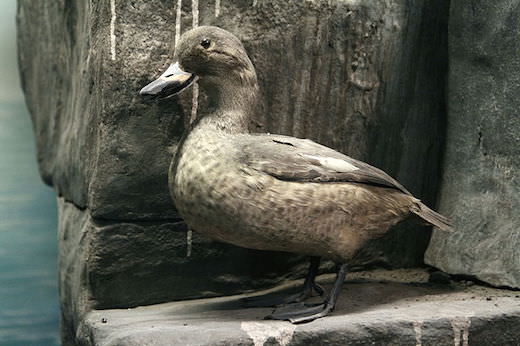Labrador duck

Extinct 1875
The Labrador duck, before it went extinct, was a rare North American bird that was considered a sea duck. It was also known as the Pied duck and the Skunk duck, named for the males white and black piebald coloration. The Labrador duck was called the Sand Shoal duck as well, which referred to its habit of feeding in shallow water. There are 54 specimen's of the Labrador duck preserved in museum collections worldwide, although some say there are actually 55 preserved specimens.
Description
The female Labrador ducks had a gray plumage that was weakly patterned, while the male plumage was black and white in an elder like pattern. The wings were entirely white, with the exception of the primaries. The Labrador duck had an oblong head with tiny, beady eyes. The ducks body was short with short, strong feet that were placed far behind the body. The bill was almost as long as the ducks body was. The Labrador duck had small feathers with a short, rounded tail. The Labrador duck closely resembled the scoter bird.
Habitat
The Labrador duck preferred sandy coasts, bays, and inlets. They migrated each year, usually to the coasts of New Jersey and New England. The Labrador duck was believed to breed either in Labrador in the summer or in Northern Quebec, however, it is not known for sure where they bred at. The ducks fed on small mollusks and maybe mussels as well. The beak of the duck was soft, therefore they are believed to have used it to probe through sediment for food too.
Reason for Extinction
The reason for the Labrador ducks extinction is still unknown, though there are several guesses as to why they are extinct. It is assumed that due to a specialized diet, the ducks were vulnerable when it came to adapting to their environment. It is also believed that an overharvest of birds and eggs on the ducks breeding grounds were a possible reason for extinction. Some people believe that they could have been subject to depredations by the feather trade, which ultimately resulted in their extinction. There could have also been a decline in mussels and other shellfish that the ducks ate, causing their demise. It is also possible that the enormous increase in human influence on the coasts caused the ducks to flee to find another habitat. However, the Labrador ducks range was limited to the American coast of the North Atlantic, which made it difficult for them to change niches. Although there are many guesses as to how they went extinct, it is still not determined what the real cause was. The last seen Labrador duck was seen in Long Island in 1875. It is now preserved in the United States National Museum in Washington. They went extinct in the late nineteenth century.